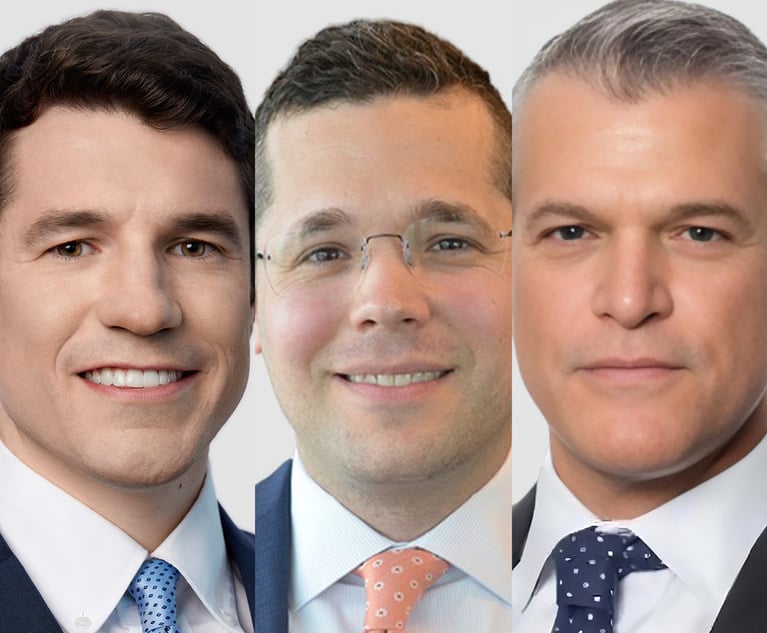Winning the PR Battle—Without Losing the War of Words
If an attorney or law firm is looking for a strategy to compete in the court of public opinion, Washington, D.C. is providing a mixed model.
February 15, 2019 at 11:18 AM
4 minute read
 Julie Talenfeld of BoardRoom PR.
Julie Talenfeld of BoardRoom PR.
If an attorney or law firm is looking for a strategy to compete in the court of public opinion, Washington, D.C. is providing a mixed model.
Debates—like those over the border wall, immigration reform, the shutdown, political and SCOTUS nominations and the ongoing investigation into Russian involvement in the election—have grown caustic, accusatory and very public.
Opposing forces flood airwaves and news feeds with statements, press conferences and announcements, as much deriding the opposition as supporting their side. What's worse, these public battles often do little to sway opinion. They instead harden already-held positions. Such debates about issues of crisis can do a disservice when aired in tit-for-tat fashion.
Now, imagine a case or dispute involving your law firm has crept its way into the public forum. It could be a high-profile case, involve a well-known or celebrity defendant, or be of great public concern, like the environment, an government project, or lawsuit over a policy issue that has divided public opinion.
It could be malfeasance at or the dissolution of a law firm itself. The situation is acrimonious, the partners or parties have flung accusations at one another, and it's become the stuff of theater—all played out in the court of public opinion.
The opportunity is there to take one of at least two paths. The parties can let their furor rage in the media. Or they can seek a less-public resolution.
What have recent lessons from the nation's capital shown us about handling such disputes or crises? Consider these tips as a primer on litigation communications.
Pick your battles. Not all battles need to become wars and not all disputes about public matters require the sides advance their positions publicly. One example is Special Counsel Robert Mueller. Over the course of its investigation, the Special Counsel's office has issued almost no public statements. Yet, when BuzzFeed reported news about alleged instructions given by President Donald Trump to his attorney, Michael Cohen, the special counsel issued a 28-word refutation. That was it. Lesson learned: Focus on your job at hand. Respond directly only when necessary. Return to your job.
Will you be first to fire? If your case seems worthy of public discourse, should you lob the first statement? Media relations professional have a saying: “Get and stay ahead of the story.” If you're trying a case with a public presence, the lack of any response or position on your part will put you at a disadvantage. To paraphrase the carpenter, think twice, move once.
But they fired first. So all had been quiet until your opposition in a case or situation decided to take to the lectern and air their side. Is a response warranted? Not always. One example: was a response unnecessary when House Speaker Nancy Pelosi and Senate Minority Leader Chuck Schumer shared a lectern after Trump made his Oval Office address regarding the border wall?Some argue the president's address aired nothing new, so a response did little to advance the cause and even made the response appear weak in tone and intent.
Beware grandstanding. Shirt pressed? Tie knot tight and centered? Cameras in a row? Check. For some publicity-seeking attorneys, the media event is a chance not only to support the case, but to showcase the personal brand. Gratuitous grandstanding, however, may not only demean the attorney or trade. It may weaken the argument. If you decide the event is warranted, work with a professional publicist to ensure the venue, staging and message weaken neither your case or your brand. This case will fade. Will your name?
Don't run afoul of the law. Bar rules and orders from the bench can place limits on how much either side can say outside the courtroom. In the heat of the moment, especially when egged on by a finding or statement from opposing counsel, stay cool. Make sure your statements are within the established bounds.
Just because there's a microphone before you doesn't mean you have to speak into it. Litigation communications requires the calm resolve to speak only in support of your case—so you don't damage your case or your brand.
Julie Talenfeld is the president of BoardroomPR, one of Florida's largest integrated marketing agencies. She can be reached at [email protected]
This content has been archived. It is available through our partners, LexisNexis® and Bloomberg Law.
To view this content, please continue to their sites.
Not a Lexis Subscriber?
Subscribe Now
Not a Bloomberg Law Subscriber?
Subscribe Now
NOT FOR REPRINT
© 2025 ALM Global, LLC, All Rights Reserved. Request academic re-use from www.copyright.com. All other uses, submit a request to [email protected]. For more information visit Asset & Logo Licensing.
You Might Like
View All
Initial Steps to Set Up a Fla. Appeal: Your Future Self (or Appellate Attorney) Will Thank You
6 minute read
Divorce Timing Is Everything: Waiting for the New Year May Have Its Advantages
4 minute read
Motions for Summary Judgment and Discovery: The 2021 Rule Changes Continue to Emerge
5 minute read
Trending Stories
- 1Legaltech Rundown: Alexi Launches an AI Litigation Tool, Hotshot Announces Private Equity Practice Courses, and More
- 26-48. It’s Comp Time Again: How To Crush Your Comp Memo
- 3'Religious Discrimination'?: 4th Circuit Revives Challenge to Employer Vaccine Mandate
- 4Fight Over Amicus-Funding Disclosure Surfaces in Google Play Appeal
- 5The Power of Student Prior Knowledge in Legal Education
Who Got The Work
Michael G. Bongiorno, Andrew Scott Dulberg and Elizabeth E. Driscoll from Wilmer Cutler Pickering Hale and Dorr have stepped in to represent Symbotic Inc., an A.I.-enabled technology platform that focuses on increasing supply chain efficiency, and other defendants in a pending shareholder derivative lawsuit. The case, filed Oct. 2 in Massachusetts District Court by the Brown Law Firm on behalf of Stephen Austen, accuses certain officers and directors of misleading investors in regard to Symbotic's potential for margin growth by failing to disclose that the company was not equipped to timely deploy its systems or manage expenses through project delays. The case, assigned to U.S. District Judge Nathaniel M. Gorton, is 1:24-cv-12522, Austen v. Cohen et al.
Who Got The Work
Edmund Polubinski and Marie Killmond of Davis Polk & Wardwell have entered appearances for data platform software development company MongoDB and other defendants in a pending shareholder derivative lawsuit. The action, filed Oct. 7 in New York Southern District Court by the Brown Law Firm, accuses the company's directors and/or officers of falsely expressing confidence in the company’s restructuring of its sales incentive plan and downplaying the severity of decreases in its upfront commitments. The case is 1:24-cv-07594, Roy v. Ittycheria et al.
Who Got The Work
Amy O. Bruchs and Kurt F. Ellison of Michael Best & Friedrich have entered appearances for Epic Systems Corp. in a pending employment discrimination lawsuit. The suit was filed Sept. 7 in Wisconsin Western District Court by Levine Eisberner LLC and Siri & Glimstad on behalf of a project manager who claims that he was wrongfully terminated after applying for a religious exemption to the defendant's COVID-19 vaccine mandate. The case, assigned to U.S. Magistrate Judge Anita Marie Boor, is 3:24-cv-00630, Secker, Nathan v. Epic Systems Corporation.
Who Got The Work
David X. Sullivan, Thomas J. Finn and Gregory A. Hall from McCarter & English have entered appearances for Sunrun Installation Services in a pending civil rights lawsuit. The complaint was filed Sept. 4 in Connecticut District Court by attorney Robert M. Berke on behalf of former employee George Edward Steins, who was arrested and charged with employing an unregistered home improvement salesperson. The complaint alleges that had Sunrun informed the Connecticut Department of Consumer Protection that the plaintiff's employment had ended in 2017 and that he no longer held Sunrun's home improvement contractor license, he would not have been hit with charges, which were dismissed in May 2024. The case, assigned to U.S. District Judge Jeffrey A. Meyer, is 3:24-cv-01423, Steins v. Sunrun, Inc. et al.
Who Got The Work
Greenberg Traurig shareholder Joshua L. Raskin has entered an appearance for boohoo.com UK Ltd. in a pending patent infringement lawsuit. The suit, filed Sept. 3 in Texas Eastern District Court by Rozier Hardt McDonough on behalf of Alto Dynamics, asserts five patents related to an online shopping platform. The case, assigned to U.S. District Judge Rodney Gilstrap, is 2:24-cv-00719, Alto Dynamics, LLC v. boohoo.com UK Limited.
Featured Firms
Law Offices of Gary Martin Hays & Associates, P.C.
(470) 294-1674
Law Offices of Mark E. Salomone
(857) 444-6468
Smith & Hassler
(713) 739-1250






